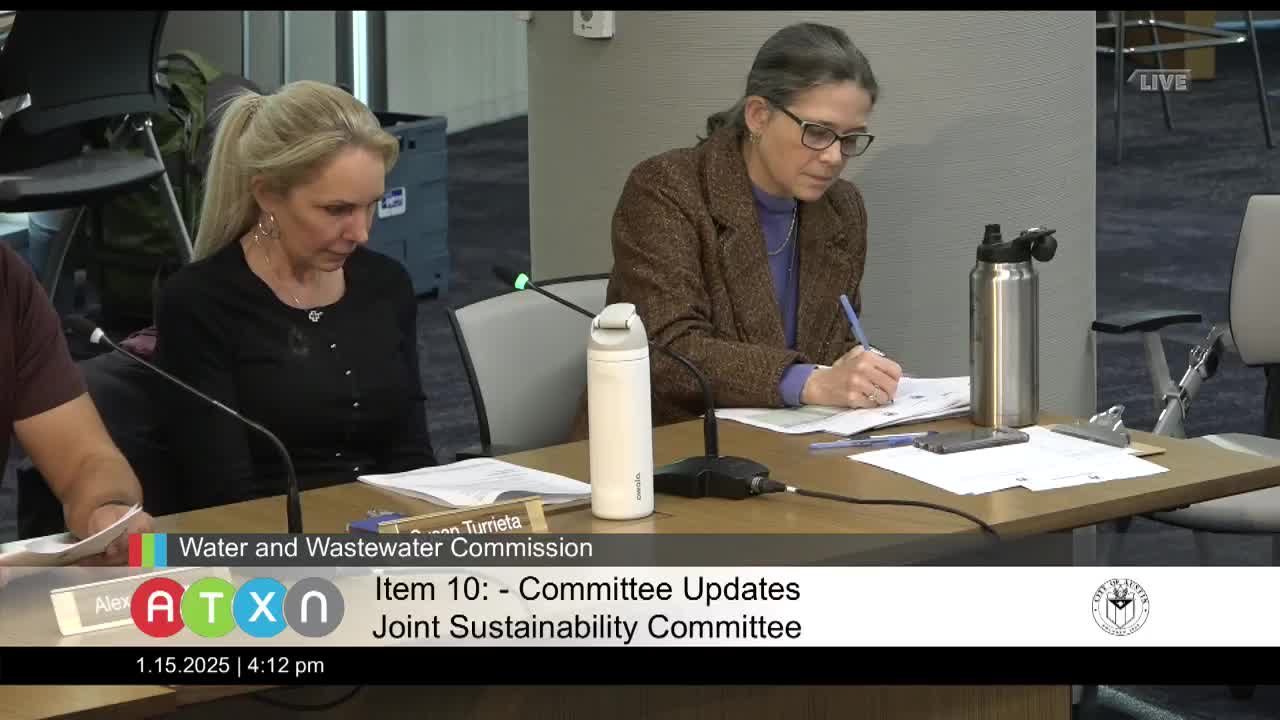Joint Sustainability Committee update: low-carbon concrete pilot lessons and urban-forest goals presented to commission
January 15, 2025 | Austin, Travis County, Texas
This article was created by AI summarizing key points discussed. AI makes mistakes, so for full details and context, please refer to the video of the full meeting. Please report any errors so we can fix them. Report an error »

The Water and Wastewater Commission on Jan. 15 received an update from the Joint Sustainability Committee (JSC) on low-carbon concrete pilot programs and Austin’s urban-forest planning.
The JSC presentation reviewed Portland, Oregon’s experience launching a low-carbon concrete program. Commissioners were told Portland’s pilots showed embodied-carbon reductions of roughly 23%–50% compared with a 100% cement mix in pilot projects, but that achieving consistent low-carbon mixes requires supplier engagement and testing because admixtures and mix designs vary among regional concrete producers.
Commissioners also heard from Emily King, Austin’s urban forester, who summarized tree-survey data and canopy goals. King reported Austin’s current tree canopy is about 41% citywide and that the Austin Climate Equity Plan sets a goal of 50% canopy coverage by 2050. To reach that goal, staff estimated roughly 39,000 acres would need to be forested or reforested. King cited Texas A&M Forest Service survey methods and said the estimated compensatory ecosystem-service value of trees in Austin is about $12.4 billion, reflecting benefits such as heat mitigation and stormwater reduction.
The presentation noted efforts to target canopy improvements equitably; the Urban Forestry Replenishment Fund supports grants for community planting projects and partners such as TreeFolks were identified as typical grant recipients. Commissioners discussed implementation concerns including supply-chain readiness for low-carbon cement, testing and inspection needs at both supplier and project levels, and structural suitability of low-carbon mixes for different project types.
Separately, Commissioner Moriarty requested a future briefing on Austin Water’s approach to new state-level funding being discussed in the Texas Legislature (referred to in the meeting as the Texas Water Fund) and urged creation of a strategy to pursue an allocation from the fund; the commissioner cited an approximate figure of $6 billion being discussed at the legislature. Staff also reported outreach to newly sworn council members and noted a council member from District 6 may request a “state of the utility” briefing for her office or the commission.
Commissioners framed both topics as long-term efforts: Portland’s low-carbon program took several years of supplier coordination and pilots before broader adoption; Austin staff and the JSC noted similar multi-year steps would be needed to scale low-carbon concrete use for city construction projects.
The JSC presentation reviewed Portland, Oregon’s experience launching a low-carbon concrete program. Commissioners were told Portland’s pilots showed embodied-carbon reductions of roughly 23%–50% compared with a 100% cement mix in pilot projects, but that achieving consistent low-carbon mixes requires supplier engagement and testing because admixtures and mix designs vary among regional concrete producers.
Commissioners also heard from Emily King, Austin’s urban forester, who summarized tree-survey data and canopy goals. King reported Austin’s current tree canopy is about 41% citywide and that the Austin Climate Equity Plan sets a goal of 50% canopy coverage by 2050. To reach that goal, staff estimated roughly 39,000 acres would need to be forested or reforested. King cited Texas A&M Forest Service survey methods and said the estimated compensatory ecosystem-service value of trees in Austin is about $12.4 billion, reflecting benefits such as heat mitigation and stormwater reduction.
The presentation noted efforts to target canopy improvements equitably; the Urban Forestry Replenishment Fund supports grants for community planting projects and partners such as TreeFolks were identified as typical grant recipients. Commissioners discussed implementation concerns including supply-chain readiness for low-carbon cement, testing and inspection needs at both supplier and project levels, and structural suitability of low-carbon mixes for different project types.
Separately, Commissioner Moriarty requested a future briefing on Austin Water’s approach to new state-level funding being discussed in the Texas Legislature (referred to in the meeting as the Texas Water Fund) and urged creation of a strategy to pursue an allocation from the fund; the commissioner cited an approximate figure of $6 billion being discussed at the legislature. Staff also reported outreach to newly sworn council members and noted a council member from District 6 may request a “state of the utility” briefing for her office or the commission.
Commissioners framed both topics as long-term efforts: Portland’s low-carbon program took several years of supplier coordination and pilots before broader adoption; Austin staff and the JSC noted similar multi-year steps would be needed to scale low-carbon concrete use for city construction projects.
View full meeting
This article is based on a recent meeting—watch the full video and explore the complete transcript for deeper insights into the discussion.
View full meeting
